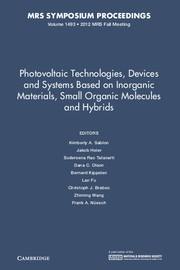Description
Photovoltaic Technologies, Devices and Systems Based on Inorganic Materials, Small Organic Molecules and Hybrids: Volume 1493
MRS Proceedings Series
Coordinators: Sablon Kimberly A., Heier Jakob, Tatavarti Sudersena Rao, Olson Dana C., Kippelen Bernard, Fu Lan, Brabec Christoph J., Wang Zhiming, Nüesch Frank A.
Symposium E and H held November 25–30 at the 2012 MRS Fall Meeting in Boston, Massachusetts.
Language: English
Subject for Photovoltaic Technologies, Devices and Systems Based on...:
Publication date: 09-2013
347 p. · 15.9x23.5 cm · Hardback
347 p. · 15.9x23.5 cm · Hardback
Description
/li>Contents
/li>
Symposium E, 'Photovoltaic Technologies - Materials, Devices and Systems', and Symposium H, 'Small Molecule Organic Solar Cells', were held November 25?30 at the 2012 MRS Fall Meeting in Boston, Massachusetts. Energy needs have been forecast to at least double within the next fifty years. Therefore, unless renewable energy can cover the large deficit that fossil fuels can no longer furnish, the stage is set for a major energy shortage. One promising solution is the conversion of solar energy into usable electric power. However, in conventional single-junction solar cells, the maximum efficiency for the conversion of unconcentrated solar radiation is 31%, because a significant part of solar energy is lost due to thermalization of photocarriers, and another part is lost due to poor or no absorption of below band gap photons. This symposium volume is focused on approaches proposed for reaching or exceeding the SQ thermodynamic limit of solar energy conversion.
Part I. Photovoltaic Technologies; Part II. Concentrated Photovoltaics (CPV); Part III. Next Generation Solar Cells; Part IV. OPV and Next Generation Solar Cells; Part V. Thin Film Solar Cells; Part VI. Silicon and Thin Film Solar Cells; Part VII. High Efficiency Solar Cells; Part VIII. Solar Cell Physics; Part IX. Characterization; Part X. Advanced Concepts.
© 2024 LAVOISIER S.A.S.
These books may interest you

Advances in Thin-Film Solar Cells 143.25 €



